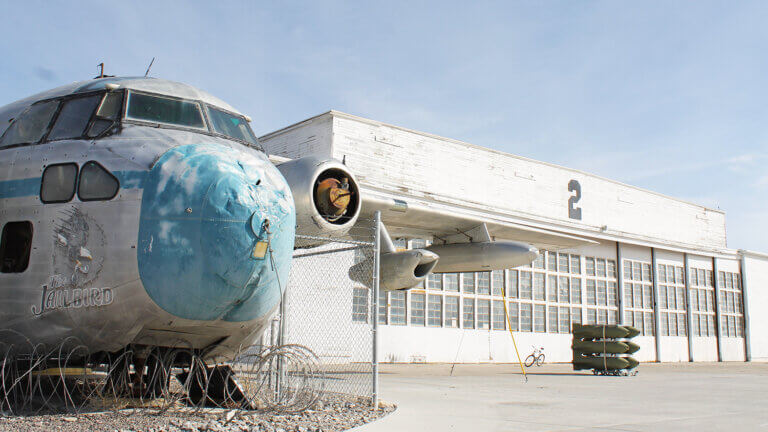The desert oasis of West Wendover may be best known today for land speed records attempted on the nearby Bonneville Salt Flats, but this state-straddling community first used this world-renowned, otherworldly landscape as a top-secret military training site during World War II. This remote desert landscape was a specialized training base for B-17 and B-24 bomber crews, including the 509th Composite Group and B-29 Enola Gay unit who carried the atomic bombs dropped over Hiroshima and Nagasaki. Today, military history lovers will discover a nearly complete historic Wendover Air Force Base-turned-Historic Wendover Airfield Museum, detailing the active base training site that operated here from 1940 to 1969, including the fully restored B-29 maintenance hangar that housed this historic aircraft.
Wendover Army Air Force Base, located just south of the town of Wendover, Utah, was first conceived of in 1939 when the Air Corps began an extensive expansion program. With a modern air war commencing in Europe, the construction of adequate bombing and gunnery ranges was high on the Army Air Corps priority list. The Air Corps desired some three million acres of land of which 90% was public domain. In 1940 the small train stop of Wendover, Utah was selected and work began in November of that year. However, because of grazing commitments to local ranchers and farmers, only 1.8 million acres were allocated. Initially, the airstrip was a sub-depot of Fort Douglas with fewer than 2 dozen troops assigned to the tar paper buildings and graded airstrip.
With the Japanese attack on Pearl Harbor, on December 7, 1941, the nation was awoken to the reality of foreign aggression and Wendover became a key base in training aircrews for action A fury of construction transformed an airfield of a dozen buildings into a base of several hundred barracks, squadron buildings, and hangars. On April 6, 1942, the first training unit arrived and found the area ideal for bombing and gunnery practice but lacking in ready facilities. Because of the remote location and lack of large population centers the base was ideal for newly created heavy bombardment groups flying the Boeing B-17 “Flying Fortress” and the Consolidated B-24 “Liberator”. Through the course of World War II, there would be 21 heavy bomb groups trained in Wendover including the 306th BG (first to daylight bomb Nazi Germany), the famed 100th BG (known as the bloody 100th due to aircraft losses), and the Flying Tigers 308th Bomb Group which served in the China Burma India theater. While remote and extreme, the base provided training that would serve the servicemen and nation well. The quality of training contributed to members of three bomb groups, trained in Wendover, in earning the Medal of Honor.
Perhaps the most historically significant role of the base was as the test and training site for the atomic bomb and the 509th Composite Group under the command of Colonel Paul W. Tibbets, Jr. It was Colonel Tibbets, flying his B-29, “Enola Gay”, who dropped the atomic bomb on Hiroshima in August 1945.
During the war years, after its activation on March 1, 1942, the nearby Wendover Army Air Field received support from Hill Field. On Dec. 31, 1945, the Army Air Forces transferred command jurisdiction of Wendover from the Second Air Force to the Air Technical Service Command, which gave the Ogden Air Depot control of the famous wartime installation. The public did not learn until after the end of World War II about the use made of Wendover in training crews in bombing tactics with specially designed B-29 Superfortresses. USAF photo
The 509th Group was organized on December 17, 1944, and trained at Wendover until May 1945, when they left for Tinian Island in the Marianas. Through the end of the War, the 216th Base Unit (Special) continued working at Wendover with the Los Alamos Scientists assembling and testing ‘Little Boy’ and ‘Fat Man’ prototypes to refine the design. During its stay at Wendover, the base became a maximum-security area with a sign stating, “What you hear here, What you see here When you leave here, let it stay here”. Led by Colonel Paul W. Tibbets, Jr. and under the training of Lieutenant Colonel Thomas Classen, the 393rd Bombardment Squadron practiced intensely to drop with optimum accuracy, a single bomb. The Wendover range proved ideal for testing and monitoring the bomb’s ballistic characteristics. Today the bomb loading pits still remain in silent testimony to the united effort of the 509th Composite Group and the national resolve to end a long and bitter war.
Wendover Air Force Base was closed in 1963, but periodically saw service into the 1980s when it hosted Air Force units participating in the famous Red Flag training exercises. Today the buildings, barracks, hospital wards, and hangars stand in tribute to the effort and very lives sacrificed in the pursuit and protection of our most precious American value, freedom.
This airfield is the most original remaining and operating WWII training airfield in the country. The importance of this site to our national history is not surpassed by any other airfield in the country. The ultimate objective of the 501(c) (3) non-profit public foundation, Historic Wendover Airfield (HWA), is to renovate multiple hangars, barracks, and support buildings, allowing visitors to ‘step back in time’ and experience an original WWII training base. Restoration of Historic Wendover Airfield is well underway with work completed or in progress on multiple buildings and exhibits. The Control Tower, Norden bombsight storage vault, dining hall, barracks, navigational aids building, Officer’s Club, and the B-29 ‘Enola Gay’ hangar are all underway or completed. To support the museum’s efforts in preserving this unique site, visit www.wendoverairfield.org































